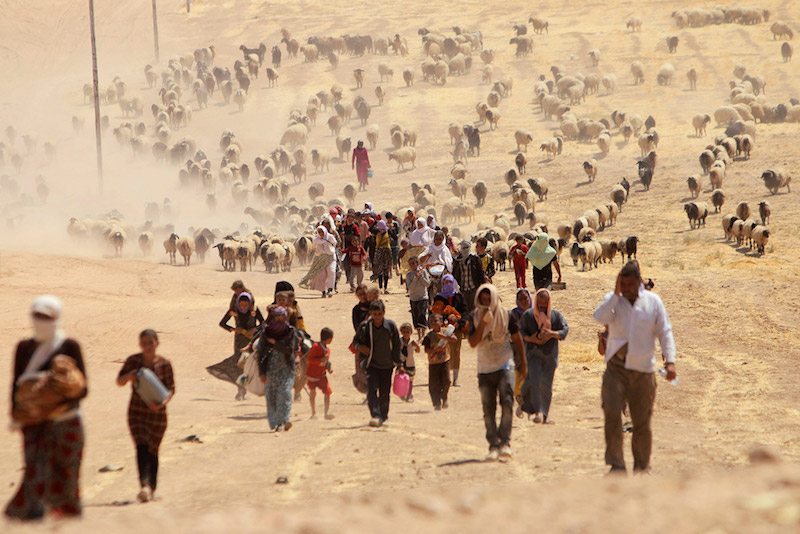Because of wars, conflicts, and persecution, there are more people around the world than at any other time since records began that have been forced to flee their homes and seek refuge and safety elsewhere, reports the UN refugee agency. Currently, across the globe there about 19.5 million people are refugees, and about half are children.
Here are 9 things you should know about how the laws, policies, and numbers regarding refugees in America:
1. The U.S. government defines “refugee” as any person who is outside any country of such person’s nationality or, in the case of a person having no nationality, is outside any country in which such person last habitually resided, and who is unable or unwilling to return to, and is unable or unwilling to avail himself or herself of the protection of, that country because of persecution or a well-founded fear of persecution on account of race, religion, nationality, membership in a particular social group, or political opinion.
2. Refugee status is also available to any persons who have been forced to abort a pregnancy or to undergo involuntary sterilization, or who has been persecuted for failure or refusal to undergo such a procedure or for other resistance to a coercive population control program.
3. The first refugee legislation in the United States was the Displaced Persons Act of 1948, which brought 400,000 Eastern Europeans to the U.S. Other refugee-related legislation included the Refugee Relief Act of 1953 (which brought in 214,000 refugees fleeing communism) and the Fair Share Refugee Act of 1960 (which mostly brought those still living in displaced persons camps after World War II). The U.S. government also used the Attorney General’s humanitarian parole authority to bring refugees into the country, beginning in 1956 with Hungarian nationals and ending with hundreds of thousands of Indochinese refugees in the 1970s.
4. The number of refugees admitted into the U.S. each year is decided by the President. Before the beginning of each fiscal year, the President, in consultation with Congress, establishes an overall refugee admissions ceiling as well as regional allocations. The total number of refugees authorized for admission in 2013 was 70,000. The largest regional allocation was to the Near East/South Asia region, which accounted for 46 percent of the authorized admissions number to continue accommodating refugee arrivals from Iraq, Iran, and Bhutan.
5. Since 1975, the U.S. has resettled more than 3 million refugees, with nearly 77 percent being either Indochinese or citizens of the former Soviet Union. Since the enactment of the Refugee Act of 1980, annual admissions figures have ranged from a high of 207,116 in 1980, to a low of 27,100 in 2002.
6. In 2013, the leading countries of nationality for refugee admissions were Iraq (28 percent), Burma (23 percent), Bhutan (13 percent), and Somalia (11 percent). Seventy-five percent of refugee admissions in 2013 were from these four countries. Other leading countries included Cuba (6.0 percent), Iran (3.7 percent), Democratic Republic of Congo (3.7 percent), and Sudan (3.1 percent).
7. Thirty-four percent of refugees admitted to the U.S in 2013 were under 18 years of age. Refugees are, on average, younger than the U.S. native-born population. In 2013, the median age of refugees arriving in the United States was 25 years; in contrast, the median age of the native-born population in 2013 was 35 years. A slight majority of refugees were male (54 percent), and 38 percent were married.
8. The leading states of residence of refugees admitted to the U.S. in 2013 were Texas (11 percent), California (9.1 percent), and Michigan (6.7 percent). Texas remained the most common destination of refugees, with arrivals increasing 26 percent from 5,905 in 2012 to 7,466 in 2013. Pennsylvania was the only state among the 10 most common destinations for refugees that experienced a decline from 2012 to 2013.
9. The Office of Refugee Resettlement (ORR) is the federal government agency charged with providing benefits and services to assist the resettlement and local integration of refugee populations. Some of the ORR programs include Refugee Cash Assistance and Refugee Medical Assistance (for up to 8 months); Refugee Social Services, such as job and language training (for up to 5 years); and temporary custody and care to unaccompanied refugee children.
Other articles in this series:
Margaret Sanger • Confederate Flag Controversy • Elisabeth Elliot • Animal Fighting • Mental Health • Prayer in the Bible • Same-sex Marriage • Genocide • Church Architecture • Auschwitz and Nazi Extermination Camps • Boko Haram • Adoption • Military Chaplains • Atheism • Intimate Partner Violence • Rabbinic Judaism • Hamas • Male Body Image Issues • Mormonism • Islam • Independence Day and the Declaration of Independence • Anglicanism • Transgenderism • Southern Baptist Convention • Surrogacy • John Calvin • The Rwandan Genocide • The Chronicles of Narnia • The Story of Noah • Fred Phelps and Westboro Baptist Church • Pimps and Sex Traffickers • Marriage in America • Black History Month • The Holocaust • Roe v. Wade • Poverty in America • Christmas • The Hobbit • Council of Trent • C.S. Lewis • Orphans • Halloween and Reformation Day • World Hunger • Casinos and Gambling • Prison Rape • 6th Street Baptist Church Bombing • 9/11 Attack Aftermath • Chemical Weapons • March on Washington • Duck Dynasty • Child Brides • Human Trafficking • Scopes Monkey Trial • Social Media • Supreme Court’s Same-Sex Marriage Cases • The Bible • Human Cloning • Pornography and the Brain • Planned Parenthood • Boston Marathon Bombing • Female Body Image Issues
